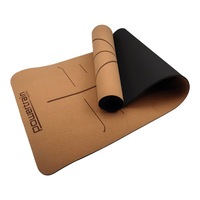 WAS
WAS



 WAS
WAS
 WAS
WAS
 WAS
WAS

The modern yoga mat is a carefully designed piece of equipment that can significantly impact your practice, whether you're a beginner or an experienced yogi.
The foundation of any good yoga mat starts with its material. Traditional PVC mats, often called "sticky mats," offer excellent durability and grip at a reasonable price point. However, as environmental consciousness has grown, many practitioners are turning to natural alternatives. Natural rubber mats provide outstanding grip and durability while being biodegradable, though they might not be suitable for those with latex allergies. Cork mats have emerged as an interesting option - they're naturally antimicrobial and become grippier as you sweat, making them perfect for hot yoga enthusiasts. TPE mats offer a middle ground, providing good performance while being more environmentally friendly than PVC.
What is The Best Thickness for a Yoga Mat?
The "best" thickness of a yoga mat depends on your specific needs, but the most versatile and widely recommended thickness is 1/8 inch (3mm). Here's why:
1/8 inch (3mm) provides a sweet spot between cushioning and stability. It's thick enough to protect your joints from hard floors but thin enough that you can still feel grounded and stable in standing poses. This thickness works well for most types of yoga and most practitioners.
However, different situations call for different thicknesses:
For joint sensitivity: If you have sensitive knees or wrists, you might prefer a thicker mat around 1/4 inch (6mm). This provides extra cushioning for kneeling poses and inversions, though you'll sacrifice some stability in balance poses.
For travel or advanced balance work: A thinner mat around 1/16 inch (1.5mm) keeps you very connected to the ground and is easier to pack, but offers minimal cushioning.
For therapeutic or restorative practices: Extra thick mats of 1/2 inch (12mm) provide maximum cushioning, but they're less practical for active practices since they can make balance poses challenging.
What is The Difference Between a Gym Mat and a Yoga Mat
A gym mat and a yoga mat serve different purposes and have distinct characteristics:
Yoga mats are thinner and designed for stability. They typically have a grippy surface to prevent slipping during poses and range from 1/16 to 1/4 inch thick. They're made to help you feel connected to the ground while providing just enough cushioning for joint comfort. The sticky texture is crucial for holding poses, especially in movements where your hands or feet might slide.
Gym mats, on the other hand, are substantially thicker - usually 1-2 inches - because they're designed for higher-impact activities. They're built to absorb shock from jumps, falls, or exercises like burpees and mountain climbers. Their surface is usually smoother and less grippy than yoga mats since stability for poses isn't their primary purpose.
Some other key differences
Size: Gym mats are often larger and wider than yoga mats
Portability: Yoga mats roll up easily for transport; gym mats are bulkier and meant to stay in place
Material: Yoga mats often use PVC or eco-friendly materials with grip in mind, while gym mats typically use dense foam focused on shock absorption
Price: Gym mats tend to be more expensive due to their size and density
Other fitness products include:
Yoga Mats Reviews
-
28/04/2025
Beautiful product
Bob
-
26/12/2024
Fantastic Quality It's rather heavy, but feels like a professional piece of equipment. A great buy under $40
Yvonne
-
24/03/2024
Best value , great to use
David Preece
-
14/03/2024
Excellent yoga mat. I wanted one a little thicker so it is perfect… great value too.
Chris
-
11/01/2024
High quality item.
Julie
-
2/09/2023
Great! Good thickness, comfy & supportive
Katie Taccarino
-
11/03/2023
Quality product better in person colour and size perfect. Will purchase again.
Moana
-
10/03/2023
Love my mat. Beautiful quality and fast delivery
Chenelle
-
1/03/2023
Fantastic durable yoga matt
Alanna Nichols
-
24/12/2022
Great mats to use as a non slip surface for pets
Deborah Sheehan
-
20/11/2022
Happy with the thickness of this.
DEBORAH
-
10/11/2022
Yoga mat looks great! Although I used it once and it already has a small tear in it, so that’s a little disappointing, but good value for money.
Holly Tingley
-
6/08/2022
I was very happy with this product. It doesn't have the plastic odour some mats can have.
Jenny
-
26/06/2022
Such a beautiful yoga & fitness mat. I love it! I love the colours, the look and the feel. It's so comfortable and so easy to roll up and carry to my gym classes. Excellent quality and value for money!
Dora
-
6/05/2022
Just what I was looking for, although cheaper ones around this is great quality for money.
Phil














































![Natural Cork TPE Yoga Mat [ONLINE ONLY]](https://assets.mydeal.com.au:443/49932/natural-cork-tpe-yoga-mat-online-only-14726517_00.jpg?v=TJJSreflHev26t0&imgclass=deallistingthumbnail)
![12 Tiles EVA Fitness Home Yoga Gym Interlocking Floor Puzzle Mat - Wood Colour [ONLINE ONLY]](https://assets.mydeal.com.au:443/49932/12-tiles-eva-fitness-home-yoga-gym-interlocking-floor-puzzle-mat-wood-colour-online-only-14726493_00.jpg?v=Dn0VdHXFaFKXZMB&imgclass=deallistingthumbnail)
![VP NBR Yoga Mat 1.5CM Blue [ONLINE ONLY]](https://assets.mydeal.com.au:443/49932/vp-nbr-yoga-mat-1-5cm-blue-online-only-14726293_00.jpg?v=1mOe3gjrquWEmb0&imgclass=deallistingthumbnail)




